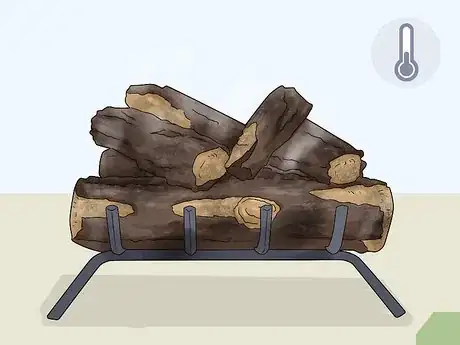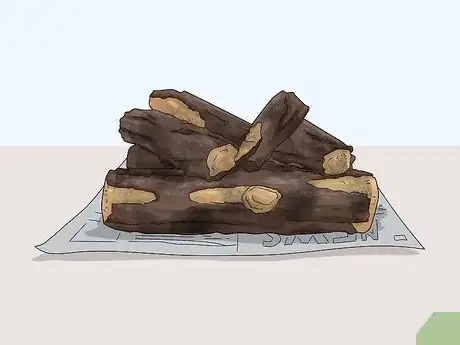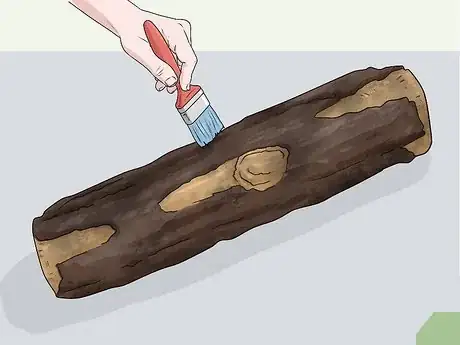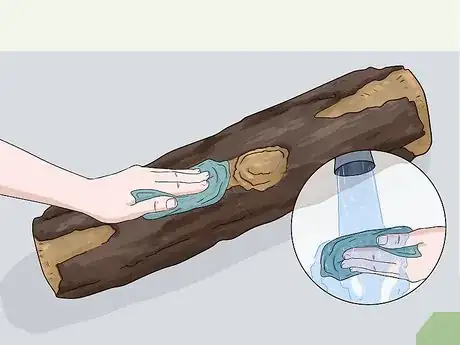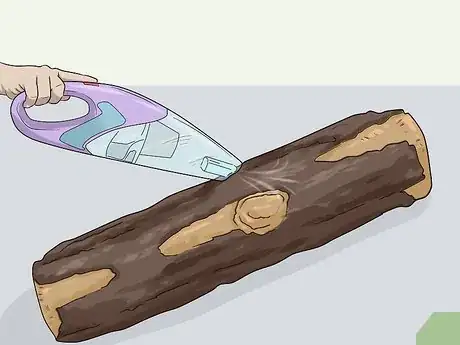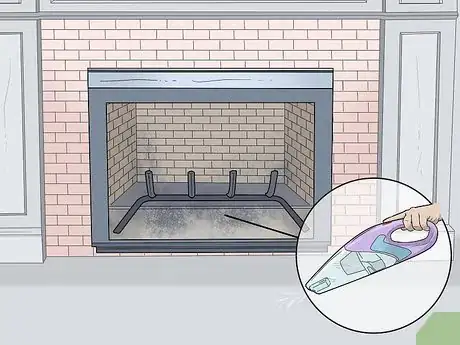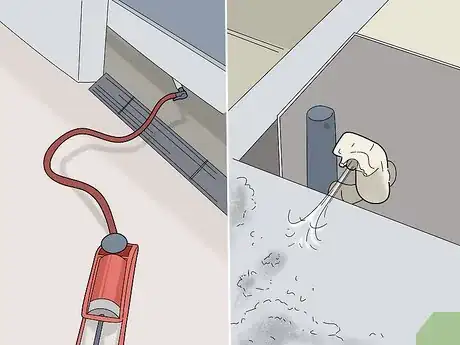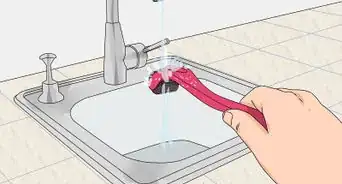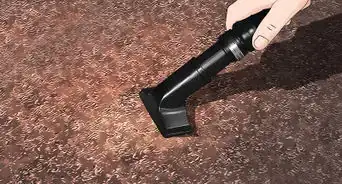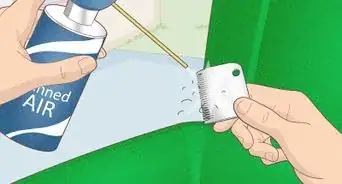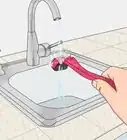This article was co-authored by Michelle Driscoll, MPH. Michelle Driscoll is the Owner of Mulberry Maids, which is based in Fort Collins, Colorado. With five years of experience, her business specializes in cleaning homes and small offices. She holds a Masters in Public Health from the Colorado School of Public Health. Additionally, Mulberry Maids has an A+ rating from the Better Business Bureau.
This article has been viewed 95,998 times.
A gas log fireplace offers a safe and energy-effective way to replicate a traditional wood fireplace. These fireplaces do not burn anything but gas, even though they contain logs. These logs are ceramic and painted to look like burning wood logs. The combustion of the gas around them still does leave behind a little soot, which typically only needs cleaning on an annual basis. To clean out the gas logs, turn off the fireplace’s pilot light, place the logs onto paper outside the fireplace, then vacuum up the soot.
Steps
Removing the Logs
-
1Turn off the pilot light. Locate the control valve on your gas log system. It is the dial you use to ignite the fireplace. Turn the dial to the "off" setting. The burner valve in the system will close, restricting gas flow and shutting off the flames.[1]
-
2Allow the logs to cool. The logs must only be handled when cool. Come back in an hour and move your hand over the front of the fireplace. Continue moving it into the unit as long as it does not feel hot.[2]Advertisement
-
3Place the logs on newspaper. When removing the logs from the fireplace, set them out on newspaper, scrap paper, an old bedsheet, or other protective surface set on the floor near you. Choose something that you won’t mind getting sooty.
- If you do not have the owner’s manual, take a picture of the log placement. Incorrect placement when you return the logs to the fireplace can void your warranty and lead to more soot.
- Inspect your logs for corrosion or damage when you remove them. If you notice any damage or blockage in the logs or fireplace, contact a professional to repair or replace them before using your fireplace again.
Cleaning the Logs
-
1Scrub the logs. Once the logs are moved out of the fireplace, use a brush to remove the soot. A small paintbrush or nylon scrub brush will reach soot in the cracks of the logs. You do not need to dip the brushes in water.
- Another option for cleaning includes using a vacuum cleaner to lift the soot. Some vacuums also have soft brush attachments that you can use to dislodge soot stuck in the cracks.
- Avoid stiff scrubbers, lots of water, or harsh cleaners. These will chip or discolor the logs.[3]
-
2Wipe the logs with a rag. To remove soot still clinging to the logs, use a dry, soft rag. Wipe it over the whole log. The soot should brush off without exposing the logs to water or cleaner that could damage the logs or create more soot.[4]
- Cleaners should only be used if they are approved in the owner’s manual.
-
3Clean the logs with a damp rag. If necessary, some logs can be treated with a small amount of water. Dip a soft cloth into lukewarm water, wringing out excess moisture. Wipe it over the logs to remove leftover soot. Check with your owner’s manual to make sure this treatment is okay.
- If you are unsure, test the rag in an inconspicuous place, such as the back side of one log, first.
- Use a soft-bristled paintbrush or cotton swab if soot is built up in small crevices.
-
4Vacuum up the soot. Run your vacuum cleaner around the logs to pick up any of the soot you brushed off. This will ensure that the soot doesn’t spread throughout your home. Once done, dispose of the paper when you are ready to return the logs to the fireplace.
Clearing Soot from the Fireplace
-
1Vacuum the soot out of the fireplace. Use a vacuum with a hose to reach into the fireplace and remove the soot that has collected on the floor. This can be done anytime, even without removing the logs, to reduce the amount of soot collecting in the fireplace.[5]
- Cover the end of your vacuum hose with cheesecloth if you have small lava rocks inside your fireplace. This prevents them from getting sucked up.
-
2Clear the pilot light line of soot. Use a compressor or a can of air no greater than 30 PSI for this. Locate the pilot light, which is where the flame lights the burners. On it, right next to its tip, is an oxygen depletion sensor that has two small holes in it. Blast air through the holes to clear them out.[6]
-
3Blow the dust out of the main burner. Follow the gas tube on the ground as it goes into the burner where the logs sit. There will be a hole or gap in the tube near where it meets the burner. This is where air mixes with gas. Clear it out using the compressor or air.
Expert Q&A
Did you know you can get expert answers for this article?
Unlock expert answers by supporting wikiHow
-
QuestionWhat causes an exhaust odor from the gas log?
 Michelle Driscoll, MPHMichelle Driscoll is the Owner of Mulberry Maids, which is based in Fort Collins, Colorado. With five years of experience, her business specializes in cleaning homes and small offices. She holds a Masters in Public Health from the Colorado School of Public Health. Additionally, Mulberry Maids has an A+ rating from the Better Business Bureau.
Michelle Driscoll, MPHMichelle Driscoll is the Owner of Mulberry Maids, which is based in Fort Collins, Colorado. With five years of experience, her business specializes in cleaning homes and small offices. She holds a Masters in Public Health from the Colorado School of Public Health. Additionally, Mulberry Maids has an A+ rating from the Better Business Bureau.
Founder, Mulberry Maids The logs can let out an exhaust odor if they are not in the correct location. Check the owners manual and make sure the logs are sitting in the fireplace as instructed. In addition, it is recommended to run the fireplace for half a day to burn off any oils or remnants that may be in there (be sure to open the windows and ventilate the house when doing this). Often times this will take care of anything you may smell. If you are still having problems, contact a professional to take a look at it.
The logs can let out an exhaust odor if they are not in the correct location. Check the owners manual and make sure the logs are sitting in the fireplace as instructed. In addition, it is recommended to run the fireplace for half a day to burn off any oils or remnants that may be in there (be sure to open the windows and ventilate the house when doing this). Often times this will take care of anything you may smell. If you are still having problems, contact a professional to take a look at it. -
QuestionDo I want to clean the holes where the flames come out, and if so, what do I use for that?
 Community AnswerAre they plugged up, or dirty looking you can. If not, and your fire burns correctly, and you get a clean flame from each hole, they do not need cleaning. In case they are plugged, try using a pipe cleaner on them.
Community AnswerAre they plugged up, or dirty looking you can. If not, and your fire burns correctly, and you get a clean flame from each hole, they do not need cleaning. In case they are plugged, try using a pipe cleaner on them. -
QuestionDo gas logs in fireplaces ever need replacement?
 LojjikCommunity AnswerYes, but not frequently. Gas logs made of ceramic will usually last longer than ones made of cement. Though the material itself rarely degrades, its appearance may after many years. The more you use your fireplace, the more quickly it will fade. But, most logs should easily last 10 or more years.
LojjikCommunity AnswerYes, but not frequently. Gas logs made of ceramic will usually last longer than ones made of cement. Though the material itself rarely degrades, its appearance may after many years. The more you use your fireplace, the more quickly it will fade. But, most logs should easily last 10 or more years.
References
- ↑ http://www.hansenwholesale.com/gas-logs/how-safety-pilot-works.asp
- ↑ https://www.rosieonthehouse.com/faqs/what-safety-precautions-should-i-take-with-my-gas-fireplace
- ↑ http://www.hargrovegaslogs.com/FAQ.html#7
- ↑ https://www.hunker.com/12344145/how-to-clean-ceramic-gas-logs
- ↑ http://www.trussville.com/safety-tips/cleaning-gas-logs/
- ↑ http://www.finesgas.com/cleaning-gas-logs
About This Article
Before cleaning your gas logs, make sure they're cool to the touch to avoid burns. Then, place them on some newspaper before removing them from the fireplace to prevent soot contamination. Once you've removed the logs, scrub the soot off them with a small paintbrush or a vacuum cleaner. If soot is still sticking to the logs, use a dry rag to wipe them. Then, vacuum up any soot from the paper around your logs. Finish by vacuuming soot out of the fireplace and cleaning the dust out of the main burner with a can of air. For advice on when you can clean your gas logs with water and a damp cloth, read on!

